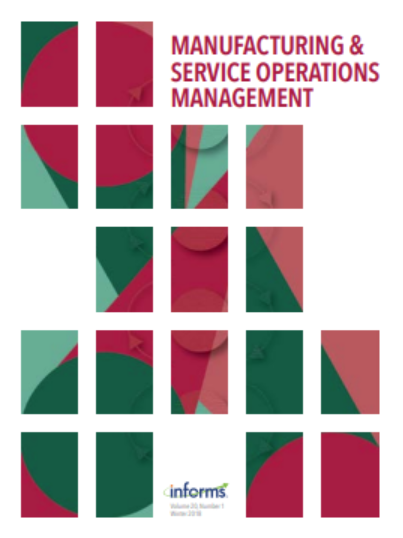排队与负网络效应
IF 4.8
3区 管理学
Q1 MANAGEMENT
M&som-Manufacturing & Service Operations Management
Pub Date : 2023-09-01
DOI:10.1287/msom.2023.1223
引用次数: 0
摘要
问题定义:在具有战略客户的马尔可夫排队系统中,完成服务会获得奖励,而等待服务会产生损失。排队文献中常见的假设是,这种损失是顾客等待时间的函数。本文采用了一种不同的新颖的方法,它模拟了客户在与他人一起等待时由于负面网络效应而产生的损失,这种损失随着与他人接触的增加而增加。方法:等待时间由两项创新措施补充,这两项措施捕捉了对加入M/M/c队列的标记客户的负面影响:标记客户遇到的客户总数以及在等待服务时与这些客户接触的个人时间。在此背景下,研究了诱导M/M/c/n型队列的阈值连接策略。结果:解析导出了在给定位置排队的顾客的暴露量和暴露时间的分布。无违约条件下的均衡被称为阈值策略。如果顾客的损失函数是凹形的(例如流行病期间感染几率的指数模型),则存在一个均衡阈值策略,在该策略下,即使允许顾客插队,顾客也不会插队。确定了由于个人行为之间缺乏协调而造成的无政府状态的代价。与所有潜在客户都具有相同效用函数的限制性假设下建立的均衡阈值不同,引入了一种新的安全阈值概念,即无论其他客户的行为如何,加入设施并待到完成服务的客户都具有正期望效用的队列大小。管理影响:排队系统中拥塞引起的负面网络效应的影响是队列管理人员感兴趣的,特别是影响等待区域的最佳大小。将安全阈值和均衡阈值与监管者设定的社会最优阈值进行了对比,并建议将安全阈值作为设计候车室大小的管理工具。本研究由以色列科学基金会资助[赠款ISF 1898/21和ISF 852/22]。补充材料:在线附录可在https://doi.org/10.1287/msom.2023.1223上获得。本文章由计算机程序翻译,如有差异,请以英文原文为准。
Queueing with Negative Network Effects
Problem definition: In a Markovian queueing system with strategic customers, a reward is gained from completing service, and a loss is incurred while waiting to be served. The common assumption in the queueing literature is that such loss is a function of the customer’s waiting time. This paper takes a different and novel approach in that it models the customer’s loss incurred because of negative network effects while waiting with others, which increases as the exposure to others increases. Methodology: Waiting time is complemented by two innovative measures that capture negative effects on a tagged customer joining an M/M/c queue: the total number of customers the tagged customer meets and person-time exposure to these customers while waiting to be served. Threshold joining strategies inducing M/M/c/n–type queues are studied in this context. Results: The distributions of exposure size and exposure time of a customer joining the queue at a given position are analytically derived. Equilibria under conditions of no reneging are identified as threshold strategies. If the customer’s loss function is concave (such as an exponential model for the chance of infection during a pandemic), there is an equilibrium threshold strategy under which customers do not renege from the queue, even if reneging is allowed. The price of anarchy caused by lack of coordination among the individuals acting is identified. Unlike the equilibrium threshold built under the restrictive assumption that all potential customers have the same utility function, a novel safe threshold concept is introduced, a queue size at which a customer who joins the facility and stays until completing service has positive expected utility regardless of the actions of the other customers. Managerial implications: The implications of negative network effects caused by congestion in a queueing system are of interest to queue managers and, in particular, affect the optimal size of the waiting area. Safe and equilibrium thresholds are contrasted with the socially optimal threshold set by a regulator, and the safe threshold is suggested as a managerial tool to design the waiting room size. Funding: This work was supported by the Israel Science Foundation [Grants ISF 1898/21 and ISF 852/22]. Supplemental Material: The online appendix is available at https://doi.org/10.1287/msom.2023.1223 .
求助全文
通过发布文献求助,成功后即可免费获取论文全文。
去求助
来源期刊

M&som-Manufacturing & Service Operations Management
管理科学-运筹学与管理科学
CiteScore
9.30
自引率
12.70%
发文量
184
审稿时长
12 months
期刊介绍:
M&SOM is the INFORMS journal for operations management. The purpose of the journal is to publish high-impact manuscripts that report relevant research on important problems in operations management (OM). The field of OM is the study of the innovative or traditional processes for the design, procurement, production, delivery, and recovery of goods and services. OM research entails the control, planning, design, and improvement of these processes. This research can be prescriptive, descriptive, or predictive; however, the intent of the research is ultimately to develop some form of enduring knowledge that can lead to more efficient or effective processes for the creation and delivery of goods and services.
M&SOM encourages a variety of methodological approaches to OM research; papers may be theoretical or empirical, analytical or computational, and may be based on a range of established research disciplines. M&SOM encourages contributions in OM across the full spectrum of decision making: strategic, tactical, and operational. Furthermore, the journal supports research that examines pertinent issues at the interfaces between OM and other functional areas.
 求助内容:
求助内容: 应助结果提醒方式:
应助结果提醒方式:


